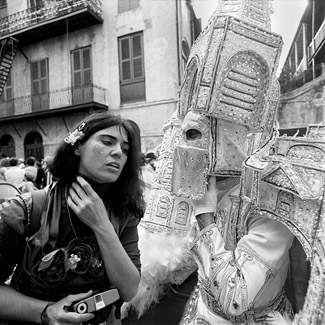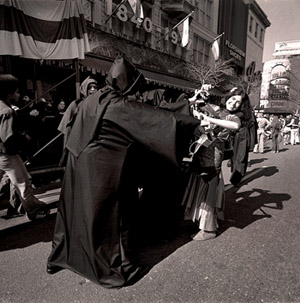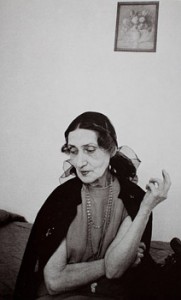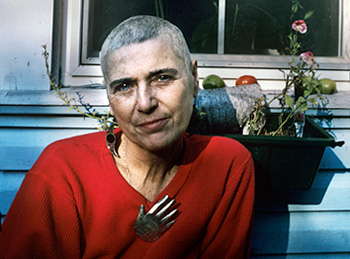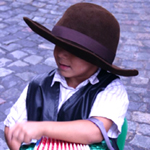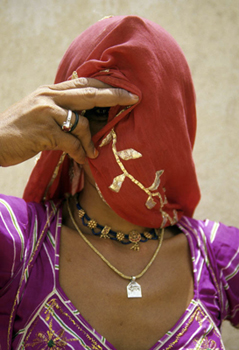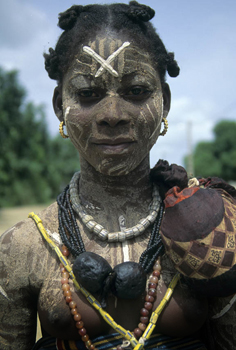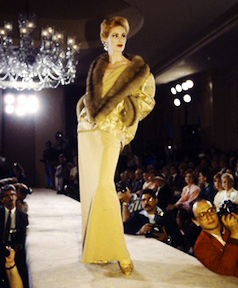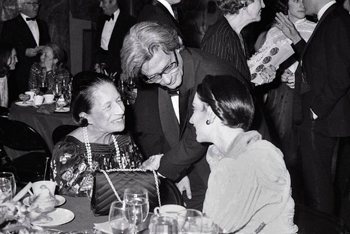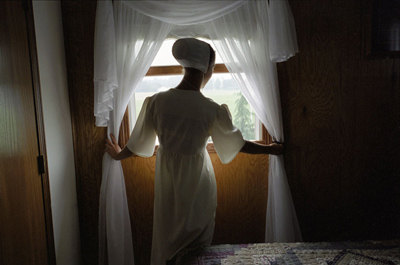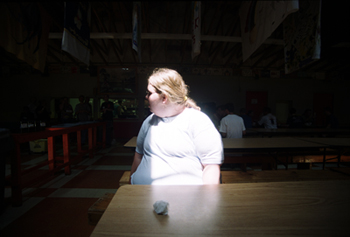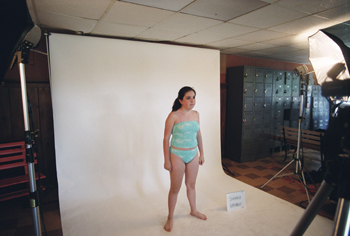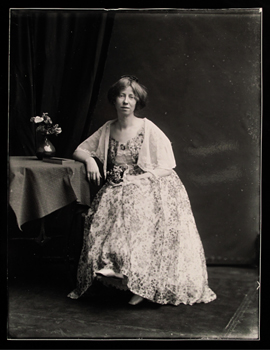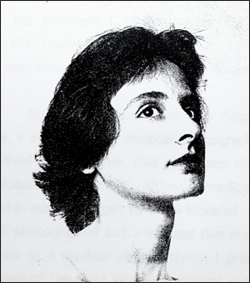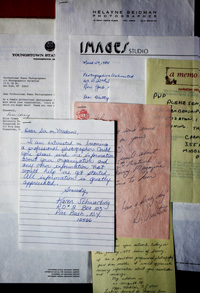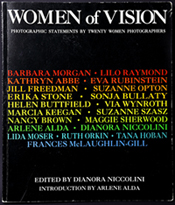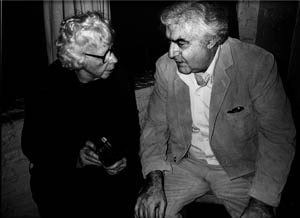Tag Archives: 30 x 30
30 By 30: Meryl Meisler / Via Wynroth
30 Women Photographers on the Women Photographers Who Inspired Them
A Blog Series in Honor of Women’s History Month, March 1 – 31
Meryl Meisler is a photographer and art teacher celebrated for her historic images of Bushwick, Brooklyn in the decades following the arson and looting of the 1977 NYC blackout. She has won fellowships from the New York Foundation for the Arts, Time Warner, Artists Space, CETA, the China Institute and the Japan Society. Her work has been exhibited at the Brooklyn Museum, the New Museum, the Dia Center NYC, MASS MoCA, and The Whitney.
Which woman photographer inspired you most?
MM: Via Wynroth, the first Education Director of the International Center of Photography-through her life, profession, and our personal connection as friends.
How did you meet?
MM: In 1977 we were both houseguests of Michael P. Smith and decided to enjoy Mardi Gras together. I had a Norita Graflex 2 ¼, and Via had a plastic Diana camera with color film. We went behind the scenes to visit the Mardi Gras Indians, the floats, the Jazz club Tipitina, then went on a big crawfish-eating frenzy. We returned to New York separately, but didn’t go our separate ways. We’d become dear friends.
What did she teach you?
MM: Via used all kinds of media and cameras-the Diana, 35mm, and 4×5-like a poet. She also made beautiful collages in shadow boxes with lace, velvet, miniature dolls, contact-sized photographs, even a deep violet butterfly! Recovering from a bone marrow transplant, she managed to videotape herself.
She taught me the importance of laughter in art and life, that equipment is less important than vision, that photography is mysterious, and teaching profound. Also that passion and integrity are more important than ambition and breaks, that time and health are never a given.
How did she come to photography?
MM: Via was born in Paris on February 20, 1940 to Jolan Gluck, and Oskar Gluck, a renowned film producer forced from his native Austria by the Nazis. It has always been my suspicion that in order to survive, that she was sent to live with a family in Paris. If so, she was another type of Holocaust survivor, a hidden Jew. After WWII, she was reunited with her parents in New York.
Via studied photography at the Art Institute of Chicago with Barbara Crane, then moved to Ithaca, New York, married, and became a staff photographer for a local newspaper. Her photos of the student protests and Students for a Democratic Society were published in Life Magazine.
But her parents were close friends of the Capas, and when Cornell Capa was planning the International Center of Photography, he invited Via to start an education program. She was the daughter Cornell and Edie never had.
Working in the education department at ICP in the 70s, did she feel a need to help women photographers?
MM: Via was empowered to imagine and bring to reality a model, radical education program. At a time when photographic education was mainly geared for commercial purposes, she founded a program that emphasized vision and art. She sought out and hired the radical, the inventive, the legendary and lesser known, men and women alike. It was a time when the idea of hiring men and women on their own artistic and intellectual merit was far from the norm. It wasn’t an “old boys club€ at ICP with Via in charge. I don’t know that she felt a need to help women photographers in particular, but she hired a lot of women photographers.
Why do women photographers matter?
MM: Whoa!! Why do women matter? Why does photography matter? This would take a lifetime of study, a PhD, a truth serum, a novel and many made for TV movies, plus museum shows and investigative reporting. They just do.
Via eventually took leave from her full time position ICP and traveled to Mexico. She would return to New York to teach ICP’s Summersite Programs, and on one of those visits, learned she had breast cancer.
She stayed, and found new joy in a home upstate in Cornwall, one with a marvelous studio. Via had lots of plans in the works: a one-woman exhibit and a book about her beloved Yucatan, that has yet to be published.
Mrs. Glück survived the passing of her only child, carried the sorrow, and maintained the house and Via’s studio exactly as it had been. When Mrs. Glück passed away, a friend cleaning the Cornwall house found Via’s photographic work that was going to be thrown away. Via’s friend Patt Blue put a halt to that and flew in from Texas to rescue Via’s work. Patt beseeched Steve Rooney, the CFO of ICP, and the ICP collections department took Via’s negatives and archives. Patt worked night and day for weeks to organize, box and bring in Via’s life’s work to ICP.
I will never forget Via Wynroth. When my spouse Pattie and I adopted a beautiful poodle/bichon with wavy black hair we tried very hard to come up with a name. Then Via, with her beautiful black hair came to mind and we named her Via, in honor of Via Wynroth. I’m sure they would both enjoy each other’s company and be proud to share their name.
[This blog post on Via Wynroth is part of a series about contemporary women photographers taking inspiration from other women photographers. The posts are usually about how the "inspiring" photographer's work touched them and affected their own work. In most cases, this inspiration is "remote," from a great, but not personally known photographer to another photographer. But in the case of Via Wynroth, it was not a "remote" mentorship, but an actual friendship. Other people who knew Via have gently corrected the details of her life that were mentioned in Meryl's reflection of her, and we have tried to incorporate these. It is wonderful to know that people care about Via and remember her, and we give thanks to them. She truly was inspiring.]
- Catherine Kirkpatrick, Archives Director
______________________________
30 By 30 blog series:
Intro: Dianora Niccolini / Women of Vision
Lauren Fleishman / Nan Goldin
Darleen Rubin / Louise Dahl-Wolfe
Dannielle Hayes / Diane Arbus
Meryl Meisler / Via Wynroth
Shana Schnur / Louise Dahl-Wolfe
Claudia Kunin / Imogen Cunningham
Gigi Stoll / Flo Fox
Robbie Kaye / Abi Hodes
Alice Sachs Zimet / Lisette Model
Juliana Sohn / Sally Mann
Susan May Tell / Lilo Raymond
Nora Kobrenik / Cindy Sherman
Caroline Coon / Ida Kar
Lisa Kahane / Jill Freedman
Karen Smul / Dorothea Lange
Claudia Sohrens / Martha Rosler
Laine Wyatt / Diane Arbus
Ruth Fremson / Strength From the Many
Greer Muldowney / Lee Miller
Rachel Barrett / Vera Lutter
Aline Smithson / Brigitte Lacombe
Ann George / Josephine Sacabo
Judi Bommarito / Mary Ellen Mark
Kay Kenny / Judy Dater
Editta Sherman / The Natural
Patt Blue / Ruth Orkin
Vicki Goldberg / Margaret Bourke-White
Beth Schiffer / Carrie Mae Weems
Anonymous / Her Mother
30 By 30: Dannielle Hayes / Diane Arbus
30 Women Photographers And the Women Photographers Who Inspired Them
A Blog Series in Honor of Women’s History Month, March 1 – 31
Dannielle Hayes is a pioneering photographer, writer and designer. She is also the founder of Professional Women Photographers. This organization grew out of the historic 1975 Fashion Institute of Technology exhibit called Breadth of Vision: Portfolios of Women Photographers. Hayes felt a need to promote both the show and the women in it, and began hosting meetings at her apartment. At the time, there were not many women working in photography, and there was a need for them to come together, share information and support each other’s projects.
Her own dedication was fierce. In 1976, she drove a truck with a projector and screen into Rockefeller Center where she parked, and showed pictures by women photographers all day long. This attracted the attention of William Morrow, and a year later Women Photograph Men, one of the first anthologies of women photographers, was published to excellent reviews.
Hayes has always championed women’s rights and human rights. She has worked on behalf of UNICEF, CARE, the United Nations’ Women’s Conference, Helen Keller International, and the 2010 Winter Paralympic Games. Her dramatic images have been widely published and exhibited, and are in the collection of the Metropolitan Museum of Art and the International Center of Photography. We are honored to have her on the blog.
Which woman photographer inspired you most?
Diane Arbus. I first became aware of her in 1968 at the beginning of my photography career, and I had the pleasure of meeting her a few years later since she was a neighbour at the time. She was an inspiration because she dared to go against the norm and not take pretty pictures but ones of so-called freaks and oddities. She was inspired by Lisette Model who taught her at the New School. I got to know Diane very well. She was shy and almost mouse-like in her behaviour. She was also subject to great periods of depression. I dedicated Women Photograph Men, published in 1977 by William Morrow, to her. I said “… dared to see reality.”
You, as many career women, have had life interruptions. Can you talk about how they affected your work?
Along with my three bouts of breast cancer beginning in 1987, my stroke in October 2010 put an end to my photography career as I knew it for 45 plus years. However, I have won a grant which enables me to look at life from a different perspective, and adapt my talents to my disability.
If you had to give one piece of advice to women photographers starting out today about the challenges they face as women and artists, what would it be?
My advice would be similar to what I told my daughter when she turned 40 this year:
- Always follow your intuition-it will be your best guide through life.
- Don’t take anything or anyone for granted.
- It won’t be easy to follow your dream, but facing life’s challenges head on will make you stronger.
_____________________________________
Diane Arbus was was born in New York in 1923. Her interest in art emerged in high school, and she had early success with her husband, Allan Arbus, in advertising and fashion photography. She studied with Lisette Model at the New School, and began to photograph people she came across in the city. Some of these images were featured in 1960 in Esquire magazine (“The Vertical Journey: Six Movements of a Moment Within the Heart of the City€), and her work began to become more widely known. While many other photographers have copied her subject matter, nobody has ever photographed like Diane Arbus. Her work is unique and unmistakable; a permanent landmark in the medium of photography. Despite her success, she struggled with depression, and died by her own hand in her Westbeth apartment in 1971.
- Catherine Kirkpatrick, Archives Director
______________________________
30 By 30 blog series:
Intro: Dianora Niccolini / Women of Vision
Lauren Fleishman / Nan Goldin
Darleen Rubin / Louise Dahl-Wolfe
Dannielle Hayes / Diane Arbus
Meryl Meisler / Via Wynroth
Shana Schnur / Louise Dahl-Wolfe
Claudia Kunin / Imogen Cunningham
Gigi Stoll / Flo Fox
Robbie Kaye / Abi Hodes
Alice Sachs Zimet / Lisette Model
Juliana Sohn / Sally Mann
Susan May Tell / Lilo Raymond
Nora Kobrenik / Cindy Sherman
Caroline Coon / Ida Kar
Lisa Kahane / Jill Freedman
Karen Smul / Dorothea Lange
Claudia Sohrens / Martha Rosler
Laine Wyatt / Diane Arbus
Ruth Fremson / Strength From the Many
Greer Muldowney / Lee Miller
Rachel Barrett / Vera Lutter
Aline Smithson / Brigitte Lacombe
Ann George / Josephine Sacabo
Judi Bommarito / Mary Ellen Mark
Kay Kenny / Judy Dater
Editta Sherman / The Natural
Patt Blue / Ruth Orkin
Vicki Goldberg / Margaret Bourke-White
Beth Schiffer / Carrie Mae Weems
Anonymous / Her Mother
30×30: Darleen Rubin / Louise Dahl-Wolfe
30 Women Photographers and the Women Photographers Who Inspired Them
A Blog Series in Honor of Women’s History Month, March 1 – 31
Darleen Rubin is a professional photographer specializing in fashion, lifestyle and celebrity portraits. Her work has appeared in The New York Post, W, Men‘s Wear Magazine, and on the cover of Women’s Wear Daily. Her vast archive of celebrity portraits includes images of Jacqueline Kennedy Onassis, Joe Namath, Mary Tyler Moore, and Elizabeth Taylor. In 2011, she was the still photographer for the independent film Somebody’s Hero, and continues to document the changing streets of her West Village neighborhood as she has for many years.
Which woman photographer inspired you most?
DR: Louise Dahl-Wolfe. She was a person of great style, and was able to bring out the depth of each person in her portraits. In her fashion work, she promoted elegance and beauty. She also had great personal strength that enabled her to establish herself as a photographer in a male dominated world, yet be respected by art directors and editors of both sexes.
When did you become aware of her?
DR: Little did I know when I began taking photographs at age 10 of my younger sister dressing up in Grandma’s old clothes, that I would one day be photographing beautiful clothes draped on beautiful and elegant women and handsome men for newspapers and magazines.
I found my own voice early, but was encouraged by seeing that other women had the same penchant. Women such as Louise Dahl-Wolfe showed the beauty of women and the clothing that adorned them, accentuating their grace and regal comportment which was important to me. Working at Women’s Wear Daily gave me the opportunity to see beauty and express my appreciation of beautiful women, elegance and style, just as I think Louise Dahl-Wolfe did at her 22 years at Harper’s Bazaar.
What did you learn from her?
DR: That I had an imagination, and should feel free to use it. It’s what gives me ideas, and is a source of creativity. Also, that I love beauty, and want everything and everyone to look beautiful.
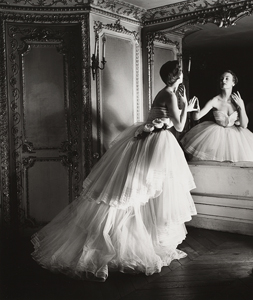
Model in Dior Ball Gown, Paris Photograph by Louise Dahl-Wolfe ©1989 Center for Creative Photography, Arizona Board of Regents
You had an experience with an astronaut…
DR: I was shooting a News & Documentary Emmy Awards event, with two powerful strobes set up. I had to work fast at these events, and had photographed many, many people, and my equipment always held up. I had just photographed James Earl Jones and George McGovern, and the lights were firing. But when James Lovell [Captain of the ill-fated Apollo 13 mission], the President of NBC News, Dateline, and other execs were on the seamless, they wouldn’t fire. I did a check of all my equipment, but everything looked okay. It was every photographer’s nightmare.
Observing my distress, Captain Lovell looked at me and said, “Do you know what we did in the Apollo program when we had technical difficulties? We’d call Mission Control and say, ‘Houston, we have a problem.’”
I raised my head, closed my eyes, and said, “God, I have a problem….Help!” And immediately I felt calm. I looked at the power pack and pressed a button which released the power, and the problem was solved.
Advice to other photographers?
DR: Shoot what you love, and be intrepid, always!
___________________________________________
Louise Dahl-Wolfe was born in in San Francisco in 1895. She studied at the California School of Fine Arts and Columbia University. In 1923, she married Meyer Wolfe and began to photograph. In 1933, she opened a studio with clients that included Bonwit Teller and Saks Fifth Avenue. As a staff photographer for Harper’s Bazaar from 1936 to 1958, she pioneered the use of natural light and location shooting for fashion photography. Her elegant and dramatic images have influenced many photographers, including Horst, Richard Avedon and Irving Penn. From 1958 to 1960 she freelanced for Vogue and other publications. She died in 1989.
“I believe that the camera is a medium of light, that one actually paints with light. In using the spotlights with reflecting lights, I could control the quality of the forms revealed to build a composition…One can work with taste and emotion and create an exciting arrangement of significant form, a meaningful photograph.€
– Louise Dahl-Wolfe, 1984
Professional Women Photographers gratefully acknowledges the Center for Creative Photography for permission to use of the Louise Dahl-Wolfe photograph, Model in Dior Ball Gown, Paris.
- Catherine Kirkpatrick, Archives Director
______________________________
30 By 30 blog series:
Intro: Dianora Niccolini / Women of Vision
Lauren Fleishman / Nan Goldin
Darleen Rubin / Louise Dahl-Wolfe
Dannielle Hayes / Diane Arbus
Meryl Meisler / Via Wynroth
Shana Schnur / Louise Dahl-Wolfe
Claudia Kunin / Imogen Cunningham
Gigi Stoll / Flo Fox
Robbie Kaye / Abi Hodes
Alice Sachs Zimet / Lisette Model
Juliana Sohn / Sally Mann
Susan May Tell / Lilo Raymond
Nora Kobrenik / Cindy Sherman
Caroline Coon / Ida Kar
Lisa Kahane / Jill Freedman
Karen Smul / Dorothea Lange
Claudia Sohrens / Martha Rosler
Laine Wyatt / Diane Arbus
Ruth Fremson / Strength From the Many
Greer Muldowney / Lee Miller
Rachel Barrett / Vera Lutter
Aline Smithson / Brigitte Lacombe
Ann George / Josephine Sacabo
Judi Bommarito / Mary Ellen Mark
Kay Kenny / Judy Dater
Editta Sherman / The Natural
Patt Blue / Ruth Orkin
Vicki Goldberg / Margaret Bourke-White
Beth Schiffer / Carrie Mae Weems
Anonymous / Her Mother
30 By 30: Lauren Fleishman / Nan Goldin
30 Women Photographers on the Women Photographers Who Inspired Them
A Blog Series in Honor of Women’s History Month, March 1 – 31
Lauren Fleishman was born and raised in Brooklyn. She won scholarships to the School of Visual Arts in New York and the Ecole Superieure des Beaux-Arts in Paris. In 2003, she was named one of Photo District News‘ 30 young photographers to watch, and was included in American Photography for four consecutive years. Her Time photo essay Sixteen Candles and a Time multimedia piece about photography as an aid to amnesia, were cited by the PDN Annual. Her work on love and aging has been exhibited at the Brooklyn Public Library, and she is currently seeking funding through Kickstarter for Love Ever After, a project about couples married 50+ years. Her clients include Time, Newsweek, Esquire, The Fader and The New York Times Magazine.
Which woman photographer inspired you the most?
LF: There are many photographers who continue to inspire me, but the first was Nan Goldin. I remember being introduced to her photographs as an undergraduate student at The School of Visual Arts. I had studied photography in high school, but the curriculum was fairly conservative and her work wasn’t covered.
What did you learn from her?
LF: Goldin’s work gave me a different understanding of photography because she made it accessible. She made it a possibility because she demonstrated that a great picture could be of your friend in her bed or at a bar or in the back of a taxi. I didn’t have to travel to some far off place or use heavy equipment to take a great photograph. But it was really the intimacy in her work that attracted me the most because I was always curious about the way that other people live.
I remember seeing a Nan Goldin shoot published in The New York Times Magazine in 1996 of sixteen year old model James King. I’ll never forget Goldin’s picture of her, backstage at a Karl Lagerfeld show, on the floor with perfect hair and a cigarette. It was just this idea of being able to see backstage that excited me so much. It was a model, but she wasn’t posed. It was a real moment, and that’s exactly the type of work I wanted to make.
From Goldin’s pictures I learned a very important lesson. I learned that I needed to make photographs that were personal to me. During my last years of college I would begin a project that would document a weight loss camp I once attended. I did this as a way to understand what had been one of the most difficult times in my life. About six years after I saw Goldin’s work, my own pictures would be published in The New York Times Magazine and it would start my career.
If you had to give one piece of advice to other photographers starting out today, what would it be?
LF: Photography can be a very difficult profession so you really need to work on projects that are meaningful to you. If you do this, no one else will be able to see it or document it in the exact same way. I also try to approach everything with an open mind. I’ve shot hundreds of assignments on so many different subjects and I always allow myself to be surprised. You need to be curious in order to stay interested. In 2008, Magnum photographer Abbas was asked the same question and I loved his answer: “Get a good pair of walking shoes and fall in love.” Being a romantic myself, I especially like the part about falling in love!
___________________________________________
Born in 1953, Nan Goldin spent much of her early life in Boston. In 1965, her older sister Barbara Holly committed suicide, an event which affected her deeply. At the alternative Satya Community School, she met friends who introduced her to the city’s gay and transsexual subculture which she began to chronicle with her camera.
After graduating from The School of the Museum of Fine Arts, she moved to New York and began photographing the New Wave music scene, and friends in the city’s drug and gay subcultures. These searing, intimate images of her “tribe” evolved into a ground-breaking multimedia piece called The Ballad of Sexual Dependency. She also documented her own dependency on alcohol and drugs, and the toll that AIDS took on her circle of friends.
Goldin’s searing night-drawn, flash-lit scenes, half real, half imagined, filled with desire, sweat and burnt out people reposing on beds and filling caskets form a unique and personal body of work that influenced many photographers. ”Snapshots are taken,” she said, “out of love and to remember people, places, and shared times. They’re about creating a history by recording a history.”
in 2006, Goldin was admitted to the French Legion of Honor, and in 2007 was given the Hasselblad Foundation International Award. Her work has been exhibited at major museums around the world, including the Museum of Modern Art, the Whitney, the Centre Pompidou, and the Louvre which commissioned Scopophilia (“the love of looking”) and gave her permission to photograph throughout the museum. She is represented by the Matthew Marks Gallery in New York.
- Catherine Kirkpatrick, Archives Director
______________________________
30 By 30 blog series:
Intro: Dianora Niccolini / Women of Vision
Lauren Fleishman / Nan Goldin
Darleen Rubin / Louise Dahl-Wolfe
Dannielle Hayes / Diane Arbus
Meryl Meisler / Via Wynroth
Shana Schnur / Louise Dahl-Wolfe
Claudia Kunin / Imogen Cunningham
Gigi Stoll / Flo Fox
Robbie Kaye / Abi Hodes
Alice Sachs Zimet / Lisette Model
Juliana Sohn / Sally Mann
Susan May Tell / Lilo Raymond
Nora Kobrenik / Cindy Sherman
Caroline Coon / Ida Kar
Lisa Kahane / Jill Freedman
Karen Smul / Dorothea Lange
Claudia Sohrens / Martha Rosler
Laine Wyatt / Diane Arbus
Ruth Fremson / Strength From the Many
Greer Muldowney / Lee Miller
Rachel Barrett / Vera Lutter
Aline Smithson / Brigitte Lacombe
Ann George / Josephine Sacabo
Judi Bommarito / Mary Ellen Mark
Kay Kenny / Judy Dater
Editta Sherman / The Natural
Patt Blue / Ruth Orkin
Vicki Goldberg / Margaret Bourke-White
Beth Schiffer / Carrie Mae Weems
Anonymous / Her Mother
30 By 30 Intro: Dianora Niccolini / Women of Vision
30 Women Photographers and the
Women Photographers Who Inspired Them
A Blog Series in honor of Women’s History Month March 1 – 31
In November of 1872, Susan B. Anthony was arrested for voting in the presidential election of the United States. She argued that she was guaranteed that right under the recently passed Fourteenth Amendment, but seven months later was convicted and fined a hundred dollars, a fine she refused to pay.
Today the world has changed and is finally waking up to the greatness of women. They run countries and write laws, lead corporations and found movements dedicated to justice and social change. Governments know that money given to them will be spent on families and education; that societies where they are empowered are more stable and enduring. In the United States, the majority of women work, in addition to caring for children, spouses and elderly parents. Their contributions are enormous.
But recognition has been slow, and the struggle continues, as does the effort to claim their own history. To make history, history has to know you’re there. For much of time, women have been invisible.
This very nearly was the case with Vivian Maier. Born in 1926, she worked as a nanny, obsessively photographing the streets of Chicago in her spare time. Only after her death when a cache of negatives was discovered in her storage unit, did the world learn of her gifts. The question is not how did she slip by, but how many other women have slipped by in every field of human endeavor? How much learning and wisdom has been lost? How much talent wasted?
For Dianora Niccolini, the lives of women photographers mattered. Born in Florence, Italy in 1936, she studied at the Germain School of Photography in New York, where she was the only woman in the class. Not worried when the men “always got the pat on the back” in school, she was appalled to find herself shut out of the marketplace. One agency told her straight: “We won’t hire women. We’ve never hired a woman as a photographer before.€
Eventually she found work at Cornell Medical College-sweeping up after the male photographers. Singled out and quizzed relentlessly by a male supervisor, she moved on, founding the medical photography departments at Lenox Hill and St. Clare’s. In her personal work, she is known for her male nudes which have been exhibited at the Witkin and Neikrug galleries, and most recently at the Florida Museum of Photographic Arts.
In today’s world the getting of information is so quick and easy that we forget it wasn’t always so. Hit a button and your laptop comes on. Touch a few keys and you can summon the work of just about any photographer in the world. But in the 1970s and 80s, if you wanted to learn about photographers and their work, you had to get a book or magazine or see a show. If you were a photographer, you had to be shown and get into print. For women photographers, fewer in number, less published and exhibited than their male counterparts, the risk of legacies slipping by was very real. Inspired by the Women’s Movement, Niccolini began to organize and publish on their behalf.
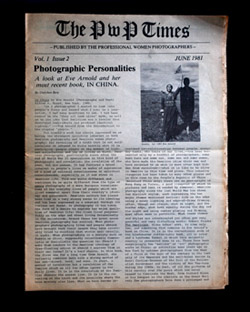 In 1974, she founded Women Photographers of New York, and in 1980, became the first president of PWP. Letters began pouring in from women all over the country begging for help on how to become a photographer. Niccolini wanted to provide information for them as well as historical context, and began publishing PWP Times.
In 1974, she founded Women Photographers of New York, and in 1980, became the first president of PWP. Letters began pouring in from women all over the country begging for help on how to become a photographer. Niccolini wanted to provide information for them as well as historical context, and began publishing PWP Times.
Each issue was devoted to a prominent woman photographer like Barbara Morgan, Maggie Sherwood, and Lisette Model, all of whom Niccolini knew personally. ”They were remarkable,” she said, ”pioneers in their own right. I wanted to highlight these women who opened the door and paved the way, especially those getting on in years.” Creating a record of their work and life was important. “You need to honor your history,” she said, “and learn from it.”
Putting out PWP Times took work. It was done on a desktop that was real, not virtual, where cut and paste were not keyboard commands. There were late hours, numerous changes using typewriter correction fluid, and mad dashes to the printer. But it was a labor of love, Niccolini’s contribution to the forward momentum of women in the field.
She also preserved the many query letters that came in. “Isn’t it interesting,” she wrote, “to read the history of our country? Can you imagine not having one?€ Reading these letters today the yearning and need is clear, as is the distance traveled by women photographers in just a few decades.
In 1982, Niccolini published WOMEN of VISON, one of the first anthologies on women photographers. In addition to their images, it also featured artistic statements, biographical sketches, and portraits of the twenty participants taken by Stephanie Cohen. Niccolini dedicated the book to Imogen Cunningham even though she was dead, because she was “a true pioneer, way ahead of her time.” That Cunningham also photographed her husband in the nude resonated with Niccolini, who was working on a series of male nudes herself.
In 1984, burnt out by work and the death of her mother, Niccolini pulled back. She concentrated on her own images and became involved in other causes. Today she remains a staunch supporter of women photographers. For her, it wasn’t one who inspired, but the many. And in honoring their lives and work, she made a lasting mark of her own.
_________________________________________________
In honor of Women’s History Month, PWP spoke with thirty women photographers about the woman photographers who influenced them. These interviews begin tomorrow with Lauren Fleishman, and will run through March 31st at www.pwponline.org/blog.
Professional Women Photographers wishes to thank the Imogen Cunningham Trust for permission to use images by Imogen Cunningham.
- Catherine Kirkpatrick, Archives Director
______________________________
30 By 30 blog series:
Intro: Dianora Niccolini / Women of Vision
Lauren Fleishman / Nan Goldin
Darleen Rubin / Louise Dahl-Wolfe
Dannielle Hayes / Diane Arbus
Meryl Meisler / Via Wynroth
Shana Schnur / Louise Dahl-Wolfe
Claudia Kunin / Imogen Cunningham
Gigi Stoll / Flo Fox
Robbie Kaye / Abi Hodes
Alice Sachs Zimet / Lisette Model
Juliana Sohn / Sally Mann
Susan May Tell / Lilo Raymond
Nora Kobrenik / Cindy Sherman
Caroline Coon / Ida Kar
Lisa Kahane / Jill Freedman
Karen Smul / Dorothea Lange
Claudia Sohrens / Martha Rosler
Laine Wyatt / Diane Arbus
Ruth Fremson / Strength From the Many
Greer Muldowney / Lee Miller
Rachel Barrett / Vera Lutter
Aline Smithson / Brigitte Lacombe
Ann George / Josephine Sacabo
Judi Bommarito / Mary Ellen Mark
Kay Kenny / Judy Dater
Editta Sherman / The Natural
Patt Blue / Ruth Orkin
Vicki Goldberg / Margaret Bourke-White
Beth Schiffer / Carrie Mae Weems
Anonymous / Her Mother


